Accountancy - Trading account | 11th Accountancy : Chapter 12 : Final Accounts of Sole Proprietors - I
Chapter: 11th Accountancy : Chapter 12 : Final Accounts of Sole Proprietors - I
Trading account
Trading account
Trading refers to buying and selling of goods with the intention of making profit. The trading account is a nominal account which shows the result of buying and selling of goods for an accounting period. According to J. R. Batliboi, “The trading account shows the results of buying and selling of goods. In preparing this account, the general establishment charges are ignored and only the transactions in goods are included."
Trading account is prepared to find out the difference between the
revenue from sales and cost of goods sold. Cost of goods sold refers to
directly related cost. Direct cost includes the purchase price of goods
purchased and all other expenses which are incurred to bring the goods to the
business premises or godown and to make these ready for sale. All the goods
purchased during the accounting period may not be sold during the same
accounting period. Hence, it is necessary to calculate the cost of goods sold
during the period. Matching principle is applied here. Hence, the cost of stock
not sold must be deducted, i.e., value of closing stock must be deducted. But
if there is any opening stock of goods that will be sold during the accounting
period, it is to be added to the cost of purchases made during the period. If
there is cost of goods manufactured, it must also be added to find out the cost
of goods sold.
Cost of goods sold = Opening stock + Net purchases + Direct expenses –
Closing stock
If the amount of sales exceeds the cost of goods sold, the difference is
gross profit. On the other hand, the excess of cost of goods sold over the
amount of sales results in gross loss.
Sales – Cost of goods sold =
Gross profit
Sales – Gross profit = Cost of goods sold
Need for preparation of trading account
Preparation of trading account serves the following purposes:
(i) Provides information about gross profit or gross loss
It shows the gross profit or gross loss of the business for an
accounting year. This helps the business persons to find out gross profit ratio
by expressing the gross profit as a percentage of sales. It helps to compare
and analyse with the ratios of the previous years. Thus, it provides data for
comparison, analysis and planning for a future period.
(ii) Provides an opportunity to safeguard against possible losses
If the ratio of gross profit has decreased in comparison to the
preceding years, effective measures can be taken to safeguard against future
losses. For example, the sale price of goods may be increased or steps may be
taken to analyse and control the direct expenses.
(iii) Provides information about direct expenses and direct incomes
All the expenses incurred on the purchase of goods are direct expenses. They are recorded in the trading account. Trading account also shows sales revenue, which is a direct income. With the help of trading account, percentage of such expenses on sales revenue can be calculated and compared with similar ratios of the previous years. Thus, it enables the management to have control over the direct expenses.
Preparation of trading account
Trading account is a nominal account. The opening stock, net purchases
and all expenses relating to purchase of goods are shown on the debit side and
the net sales and closing stock are shown on the credit side of it.
A) Items shown on the debit side of the trading account
The following are the items shown on the debit side of the trading
account:
(i) Opening stock
The stock of goods remaining unsold at the end of the previous year is
the opening stock of the current year. This item will not be there in a newly
started business. It will not appear if it is adjusted with purchases. As
opening stock would have been sold during the year, the cost of opening stock
is included in trading account.
(ii) Purchases and purchases returns
Goods which have been bought for
resale are termed as purchases. Goods purchased which are returned to suppliers
are termed as purchases returns or returns outward. Purchases include both cash
purchases and credit purchases. Net purchases, i.e., purchases minus purchases
returns are shown in the debit side of the trading account.
(iii) Direct expenses
All the expenses incurred on the purchase of goods and for bringing the
goods to the go down or place of business and to make them to saleable
condition are known as direct expenses. They are debited to trading account.
Direct expenses include the following:
(a) Carriage inwards or Freight
inwards
Amount paid for transporting the goods purchased to the godown or
business premises is called carriage inwards or carriage on purchases or
freight inwards.
(b) Wages
Amount paid to workers who are directly engaged in loading, unloading
and handling of goods purchased is known as wages.
(c) Dock Charges
These are the charges levied for shipping the cargo while entering or
leaving docks. When they are paid on import of goods, they are treated as
direct expenses.
(d) Octroi
This is a tax levied by the local authority when the purchased goods
enter the municipal limits.
(e) Import duty
Taxes paid on import of goods are known as import duties.
(f) Royalty
This is the amount paid to the owner of a mine or a patent for using owner’s right. When the royalty is based on cost of production or output, it is treated as a direct expense.
(g) Coal, gas, fuel and power
Cost incurred towards coal, gas and fuel to make the goods saleable is
also considered as direct expenses.
(iv) Cost of goods manufactured
If the sole proprietor is also engaged in manufacture of goods, a
separate account, namely, manufacturing account is to be prepared in which
expenses incurred for manufacture of goods will be entered. Examples of such
expenses are raw materials, coal, gas, fuel, water, power, factory rent,
packaging, factory lighting, royalty on manufactured goods, etc. The total cost
of goods manufactured is transferred to the debit side of trading account.
B) Items shown on the credit side of the trading account
Following are the items shown on the credit side of the trading account:
(a) Sales and Sales returns
Both cash and credit sales of
goods will be included in sales. The sales account will show credit balance
whereas the sales returns account will show debit balance. The amount of net
sales is shown on the credit side of the trading account by deducting sales
returns from sales.
(b) Closing stock
The goods remaining unsold at the
end of the accounting period are known as closing stock. They are valued at
cost price or net realisable value (market price) whichever is lower as per
Accounting Standard 2 (Revised).
3. Closing of trading account
The difference between the totals of two sides of the trading account
indicates either gross profit or gross loss. If the total of the credit side is
more, the difference represents gross profit. On the other hand, if the total
of the debit side is higher, the difference represents gross loss. The gross
profit or gross loss is transferred to profit and loss account.
4. Format of trading account
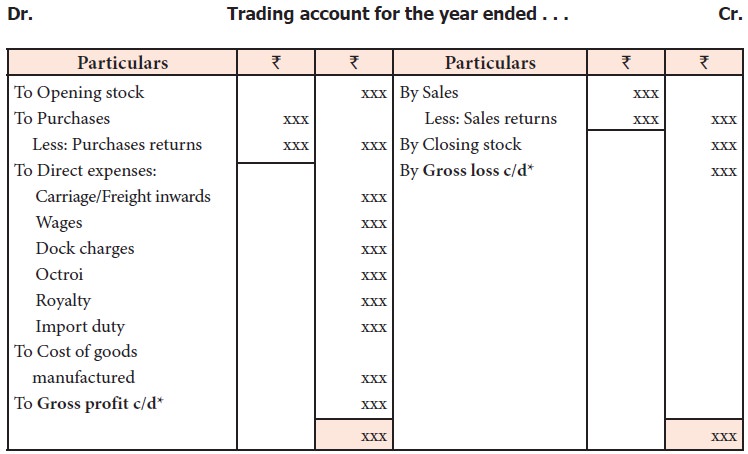
The heading of the trading account contains the words ‘for the year
ended……’ as it discloses the sales
and cost of goods sold of the business for the whole accounting year.
Illustration 1
From the following information,
prepare trading account for the year ended 31.12.2016.

Solution

Illustration 2
From the following balances extracted
from the books of M/s. Lavanya and sons, prepare trading account for the year
ended 31st March, 2017:

Solution
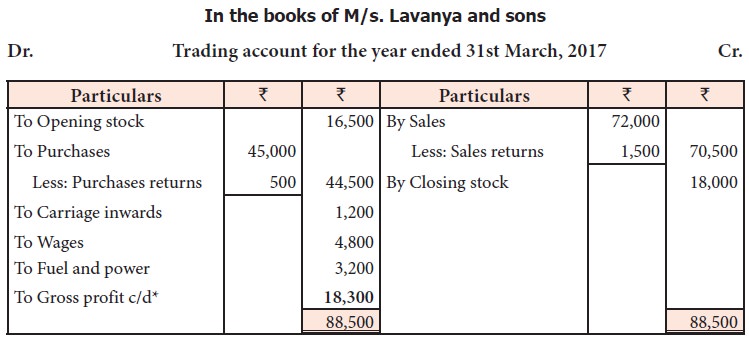
Illustration 3
Prepare trading account for the
year ended 31st December, 2017, from the following balances:

Solution
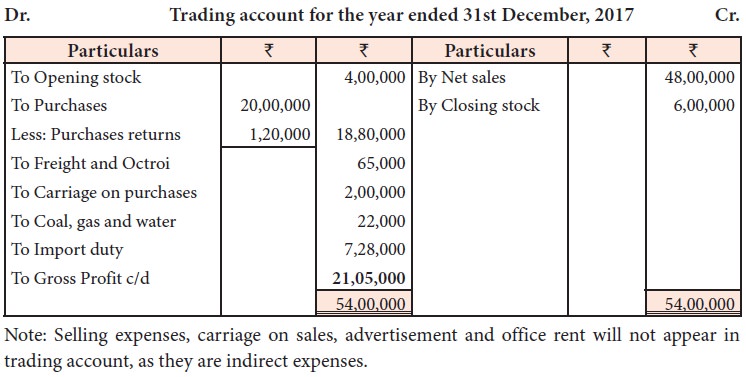
Note: Selling expenses, carriage on sales, advertisement and office rent
will not appear in trading account, as
they are indirect expenses.
Illustration 4
Following is the extract of a trial balance as on 31st December, 2017.
Prepare trading account.

Solution
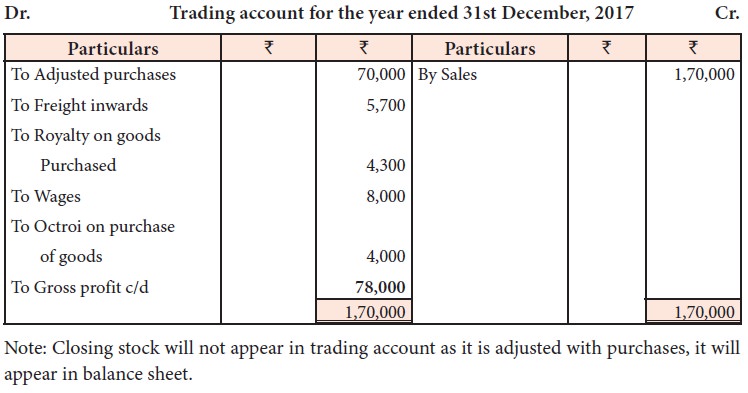
Illustration 5
From the following information, prepare trading account for the year
ending 31st December, 2017.
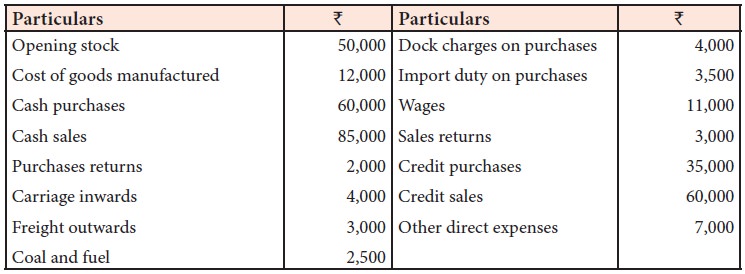
Solution
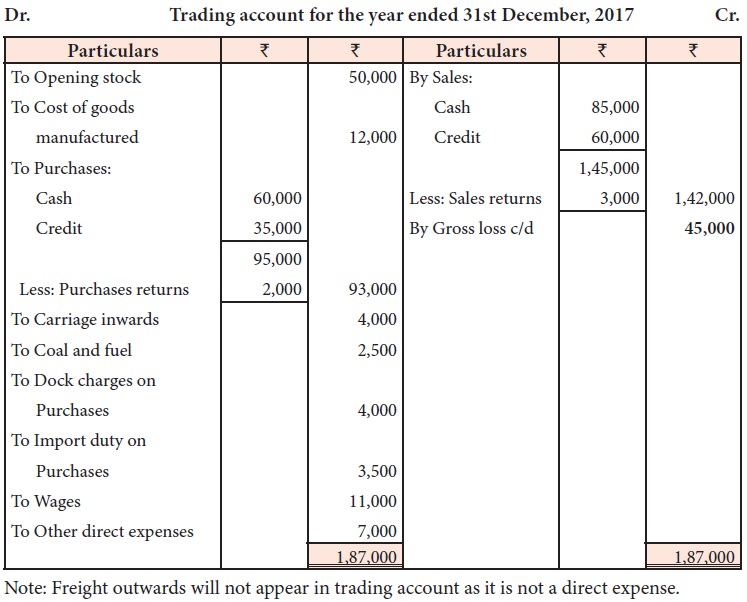
Illustration 6
Compute cost of goods sold from
the following information:

Solution
Cost of goods sold =
Opening stock + Net purchases + Direct expenses – Closing stock
= 8,000 + 60,000 + 5,000 – 9,000
= Rs. 64,000
Note: Indirect expenses do not form
part of cost of goods sold.
Illustration 7
Find out the amount of sales from
the following information.

Solution
Cost of goods sold =
Opening stock + Net purchases + Direct expenses – Closing stock
=20,000 +
70,000 + 10,000-30,000
Related Topics